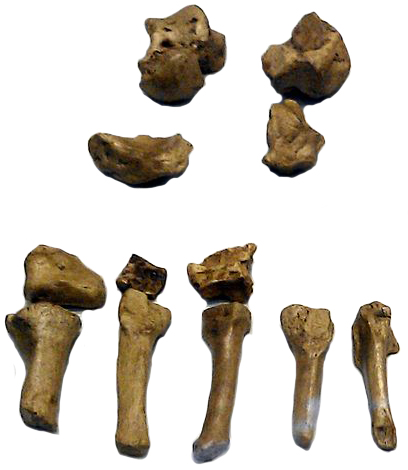
- Kidd RS, O'Higgins P & Oxnard CE (1996). "The OH8 foot: A reappraisal of the functional morphology of the hindfoot utilising a multivariate analysis". Journal of Human Evolution. 31 (3): 269–292. Can be read here.
Olduvai Hominid number 8 (OH 8) is a fossilized foot of an early hominin found in Olduvai Gorge by Louis Leakey in the early 1960s. Subsequent analysis has provoked much thought. Recent analysis (Kidd, O'Higgins & Oxnard, JHE, 1996) has demonstrated quite clearly that the fossil assemblage exhibits both ape and human characteristics. Essentially, the lateral side (i.e. the outside of the foot) contains human-like characteristics while the medial side (i.e. the side towards the midline) contains ape-like features proximally, and human-like features distally. Specifically, the cuboid (laterally) is human-like, the talus and navicular (medially) are ape-like, and the medial cuneiform (medially), is human-like. This may be looked upon as a missing link in terms of mid-tarsal joint function. Later fossil finds, as exemplified by the so-called "Little Foot" (Stw573), do not contradict this - they in fact complement this finding (Kidd & Oxnard 2004).
For more information, click here. Or, Try these sources:
- M. H. Day & B. A. Wood (1968). "Functional Affinities of the Olduvai Hominid 8 Talus". Man, New Series, Vol. 3, No. 3 (Sep., 1968), pp. 440-455. Royal Anthropological Institute of Great Britain and Ireland. 3 (3): 440–455. doi:10.2307/2798879. JSTOR 2798879. Can be read here.
- Bernhard Zipfel & Robert S. Kidd. Size and shape of a human foot bone from Klasies River main site, South Africa. Palaeont. afr. (April 2008) 43: 51–56.